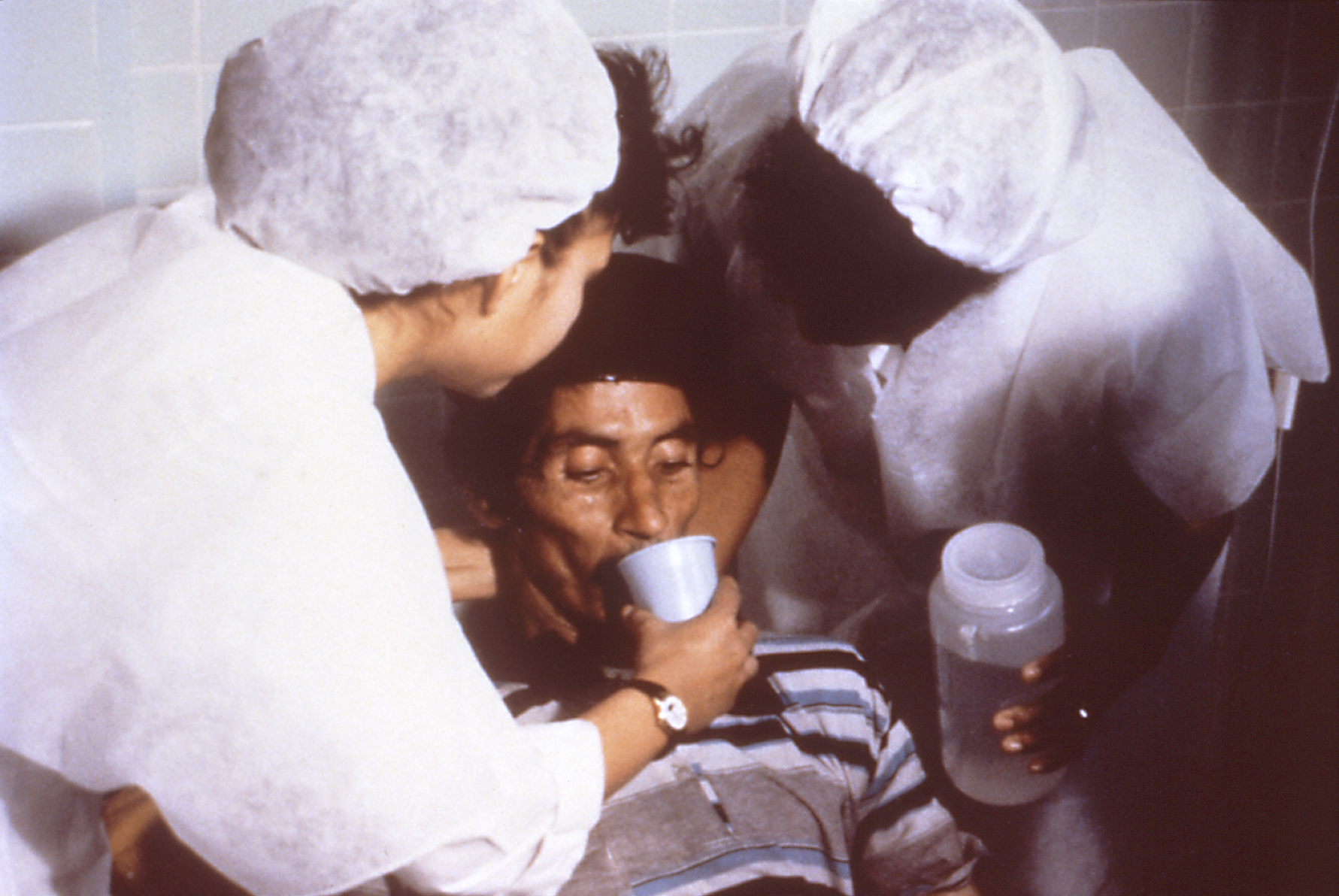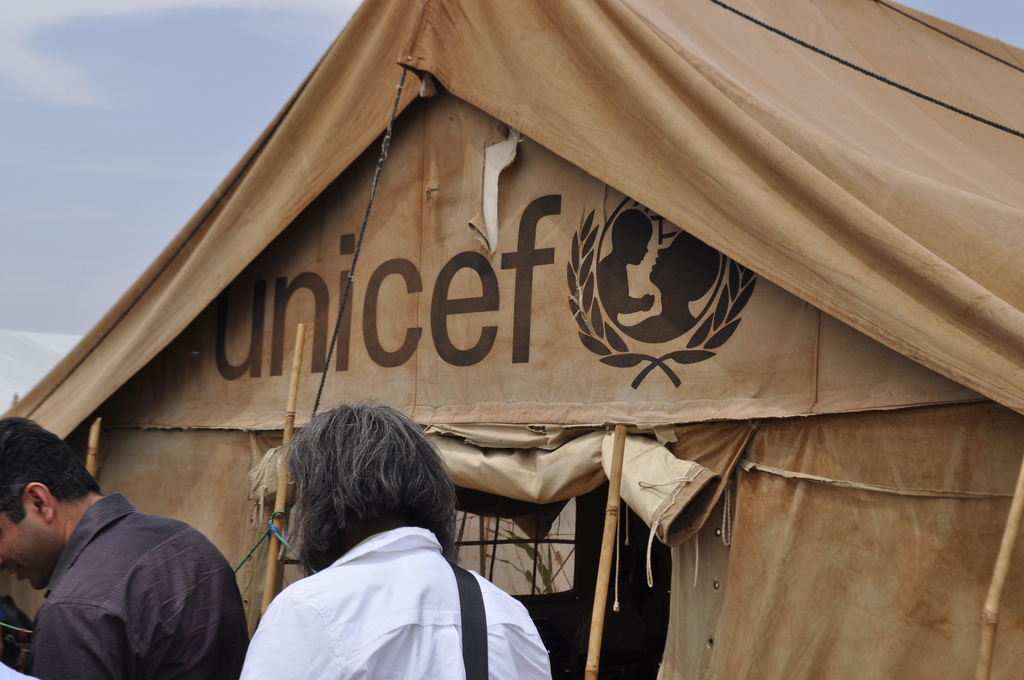|
Management Of Dehydration
Dehydration can occur as a result of diarrhea, vomiting, water scarcity, physical activity, and alcohol consumption. Management of dehydration (or rehydration) seeks to reverse dehydration by replenishing the lost water and electrolytes. Water and electrolytes can be given through a number of routes, including oral, intravenous, and rectal. In diarrhea When diarrhea occurs, hydration should increase to prevent dehydration. The WHO recommends using the oral rehydration solution (ORS) if available, but homemade solutions such as salted rice water, salted yogurt drinks, vegetable and chicken soups with salt can also be given. The goal is to provide both water and salt: drinks can be mixed with half a teaspoon to full teaspoon of salt (from one-and-a-half to three grams) added per liter. Clean plain water can also be one of several fluids given. ORS is mass-produced as commercial solutions such as Pedialyte, and relief agencies such as UNICEF widely distribute packets of pre-mixe ... [...More Info...] [...Related Items...] OR: [Wikipedia] [Google] [Baidu] |
Dehydration
In physiology, dehydration is a lack of total body water that disrupts metabolic processes. It occurs when free water loss exceeds intake, often resulting from excessive sweating, health conditions, or inadequate consumption of water. Mild dehydration can also be caused by immersion diuresis, which may increase risk of decompression sickness in divers. Most people can tolerate a 3-4% decrease in total body water without difficulty or adverse health effects. A 5-8% decrease can cause fatigue and dizziness. Loss of over 10% of total body water can cause physical and mental deterioration, accompanied by severe thirst. Death occurs with a 15 and 25% loss of body water.Ashcroft F, Life Without Water in Life at the Extremes. Berkeley and Los Angeles, 2000, 134-138. Mild dehydration usually resolves with oral rehydration, but severe cases may need intravenous fluids. Dehydration can cause hypernatremia (high levels of sodium ions in the blood). This is distinct from hypovolemia ... [...More Info...] [...Related Items...] OR: [Wikipedia] [Google] [Baidu] |
Diarrhea
Diarrhea (American English), also spelled diarrhoea or diarrhœa (British English), is the condition of having at least three loose, liquid, or watery bowel movements in a day. It often lasts for a few days and can result in dehydration due to fluid loss. Signs of dehydration often begin with loss of the normal stretchiness of the skin and irritable behaviour. This can progress to decreased urination, loss of skin color, a fast heart rate, and a decrease in responsiveness as it becomes more severe. Loose but non-watery stools in babies who are exclusively breastfed, however, are normal. What is diarrhea? How is it caused, treated and prevented? (see also script)The most common cause is an infection of the intestines due to a virus, bacterium, or parasite—a condition also known as gastroenteritis. These infections are often acquired from food or water that has been contaminated by feces, or directly from another person who is infected. The three types of diarrhea ... [...More Info...] [...Related Items...] OR: [Wikipedia] [Google] [Baidu] |
Oral Rehydration Therapy
Oral rehydration therapy (ORT) also officially known as Oral Rehydration Solution is a type of fluid replacement used to prevent and treat dehydration, especially due to diarrhea. It involves drinking water with modest amounts of sugar and salts, specifically sodium and potassium. Oral rehydration therapy can also be given by a nasogastric tube. Therapy can include the use of zinc supplements to reduce the duration of diarrhea in infants and children under the age of 5. Use of oral rehydration therapy has been estimated to decrease the risk of death from diarrhea by up to 93%. Side effects may include vomiting, high blood sodium, or high blood potassium. If vomiting occurs, it is recommended that use be paused for 10 minutes and then gradually restarted. The recommended formulation includes sodium chloride, sodium citrate, potassium chloride, and glucose. Glucose may be replaced by sucrose and sodium citrate may be replaced by sodium bicarbonate, if not available, althoug ... [...More Info...] [...Related Items...] OR: [Wikipedia] [Google] [Baidu] |
Pedialyte
Pedialyte is an oral electrolyte solution manufactured by Abbott Laboratories and marketed for use in children. It was invented by Dr. Gary Cohen of Swampscott, Massachusetts, Swampscott, Massachusetts, and was first issued to hospitals in 1966. Non-hospital sales to consumers began in 1969. Description Pedialyte is claimed to promote rehydration and electrolyte replacement in ill children. Pedialyte is lower in sugars than most sports drinks, containing 100 kilocalories per liter compared to approximately 240 in Gatorade. It contains more sodium (1,035 milligrams per liter vs. 465 mg/L in Gatorade) and potassium (780 milligrams per liter vs. 127 mg/L in Gatorade). Pedialyte does not contain sucrose, because this sugar has the potential to make diarrhea worse by drawing water into the intestine, increasing the risk of dehydration. In its flavored formulations, Pedialyte uses the synthetic sweeteners sucralose and acesulfame potassium. Pedialyte has become a Fluid replacement, ... [...More Info...] [...Related Items...] OR: [Wikipedia] [Google] [Baidu] |
UNICEF
UNICEF ( ), originally the United Nations International Children's Emergency Fund, officially United Nations Children's Fund since 1953, is an agency of the United Nations responsible for providing Humanitarianism, humanitarian and Development aid, developmental aid to children worldwide. The organization is one of the most widely known and visible social welfare entities globally, operating in 192 countries and territories. UNICEF's activities include providing immunizations and disease prevention, administering Antiretroviral drug, treatment for children and mothers with HIV, enhancing childhood and maternal nutrition, improving sanitation, promoting education, and providing emergency relief in response to disasters. UNICEF is the successor of the United Nations International Children's Emergency Fund, and was created on 11 December 1946, in New York, by the United Nations Relief and Rehabilitation Administration, U.N. Relief Rehabilitation Administration to provide immediate r ... [...More Info...] [...Related Items...] OR: [Wikipedia] [Google] [Baidu] |
Soft Drinks
A soft drink (see § Terminology for other names) is a class of non-alcoholic drink, usually (but not necessarily) carbonated, and typically including added sweetener. Flavors used to be natural, but now can also be artificial. The sweetener may be a sugar, high-fructose corn syrup, fruit juice, a sugar substitute (in the case of diet sodas), or some combination of these. Soft drinks may also contain caffeine, colorings, preservatives and other ingredients. Coffee, tea, milk, cocoa, and unaltered fruit and vegetable juices are not considered soft drinks. Soft drinks are called "soft" in contrast with "hard" alcoholic drinks. Small amounts of alcohol may be present in a soft drink, but the alcohol content must be less than 0.5% of the total volume of the drink in many countries and localities See §7.71, paragraphs (e) and (f). if the drink is to be considered non-alcoholic. Types of soft drinks include lemon-lime drinks, orange soda, cola, grape soda, cream soda, ... [...More Info...] [...Related Items...] OR: [Wikipedia] [Google] [Baidu] |
Hydrational Fluid
Oral rehydration therapy (ORT) also officially known as Oral Rehydration Solution is a type of fluid replacement used to prevent and treat dehydration, especially due to diarrhea. It involves drinking water with modest amounts of sugar and salts, specifically sodium and potassium. Oral rehydration therapy can also be given by a nasogastric tube. Therapy can include the use of zinc supplements to reduce the duration of diarrhea in infants and children under the age of 5. Use of oral rehydration therapy has been estimated to decrease the risk of death from diarrhea by up to 93%. Side effects may include vomiting, high blood sodium, or high blood potassium. If vomiting occurs, it is recommended that use be paused for 10 minutes and then gradually restarted. The recommended formulation includes sodium chloride, sodium citrate, potassium chloride, and glucose. Glucose may be replaced by sucrose and sodium citrate may be replaced by sodium bicarbonate, if not available, although ... [...More Info...] [...Related Items...] OR: [Wikipedia] [Google] [Baidu] |
Nasogastric Tube
Nasogastric intubation is a medical process involving the insertion of a plastic tube (nasogastric tube or NG tube) through the nose, down the esophagus, and down into the stomach. Orogastric intubation is a similar process involving the insertion of a plastic tube (orogastric tube) through the mouth. Abraham Louis Levin invented the NG tube. Nasogastric tube is also known as Ryle's tube in Commonwealth countries, after John Alfred Ryle. Uses A nasogastric tube is used for feeding and administering drugs and other oral agents such as activated charcoal. For drugs and for minimal quantities of liquid, a syringe is used for injection into the tube. For continuous feeding, a gravity based system is employed, with the solution placed higher than the patient's stomach. If accrued supervision is required for the feeding, the tube is often connected to an electronic pump which can control and measure the patient's intake and signal any interruption in the feeding. Nasogastric tubes may ... [...More Info...] [...Related Items...] OR: [Wikipedia] [Google] [Baidu] |
Semper Rehydration Solution
Semper rehydration solution is a mixture used for the management of dehydration. Each liter of Semper rehydration solution contains 189 mmol glucose Glucose is a sugar with the Chemical formula#Molecular formula, molecular formula , which is often abbreviated as Glc. It is overall the most abundant monosaccharide, a subcategory of carbohydrates. It is mainly made by plants and most algae d ..., 40 mmol Na+, 35 mmol Cl−, 20 mmol K+ and 25 mmol HCO3−. References Body water Medical treatments sv:Vätskeersättning#Sempers vätskeersätttning {{Medicine-stub ... [...More Info...] [...Related Items...] OR: [Wikipedia] [Google] [Baidu] |




